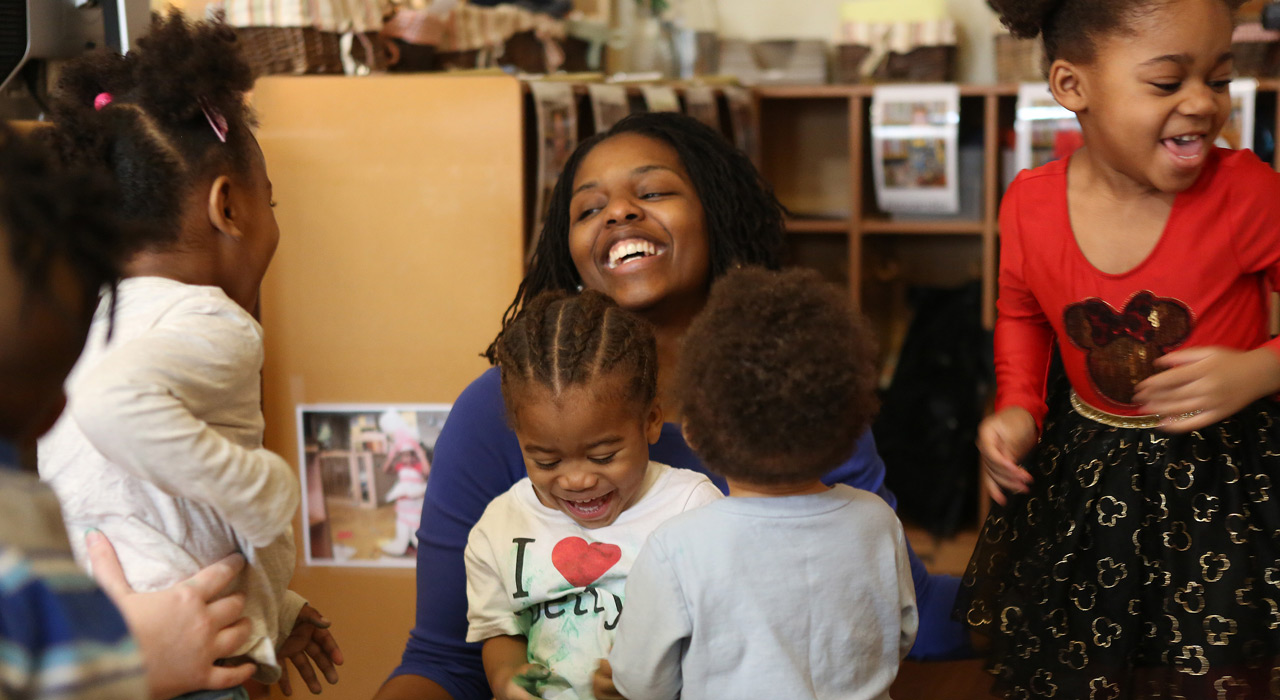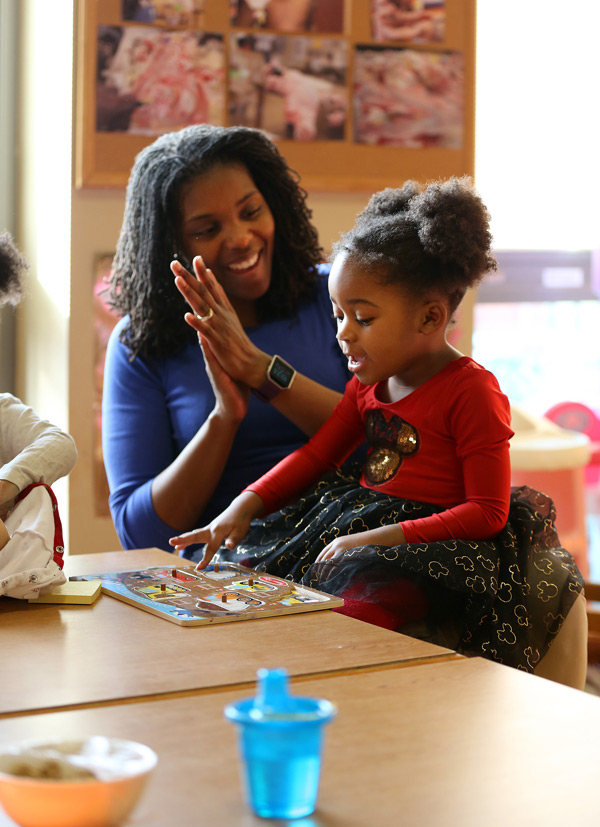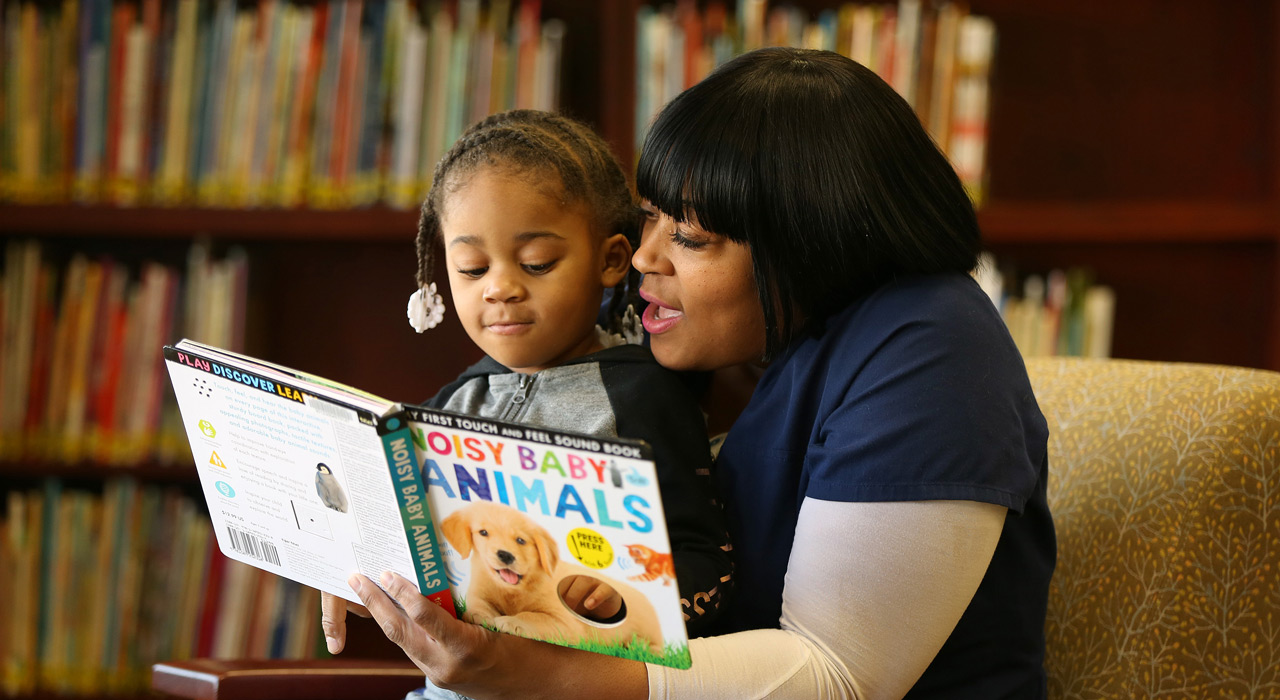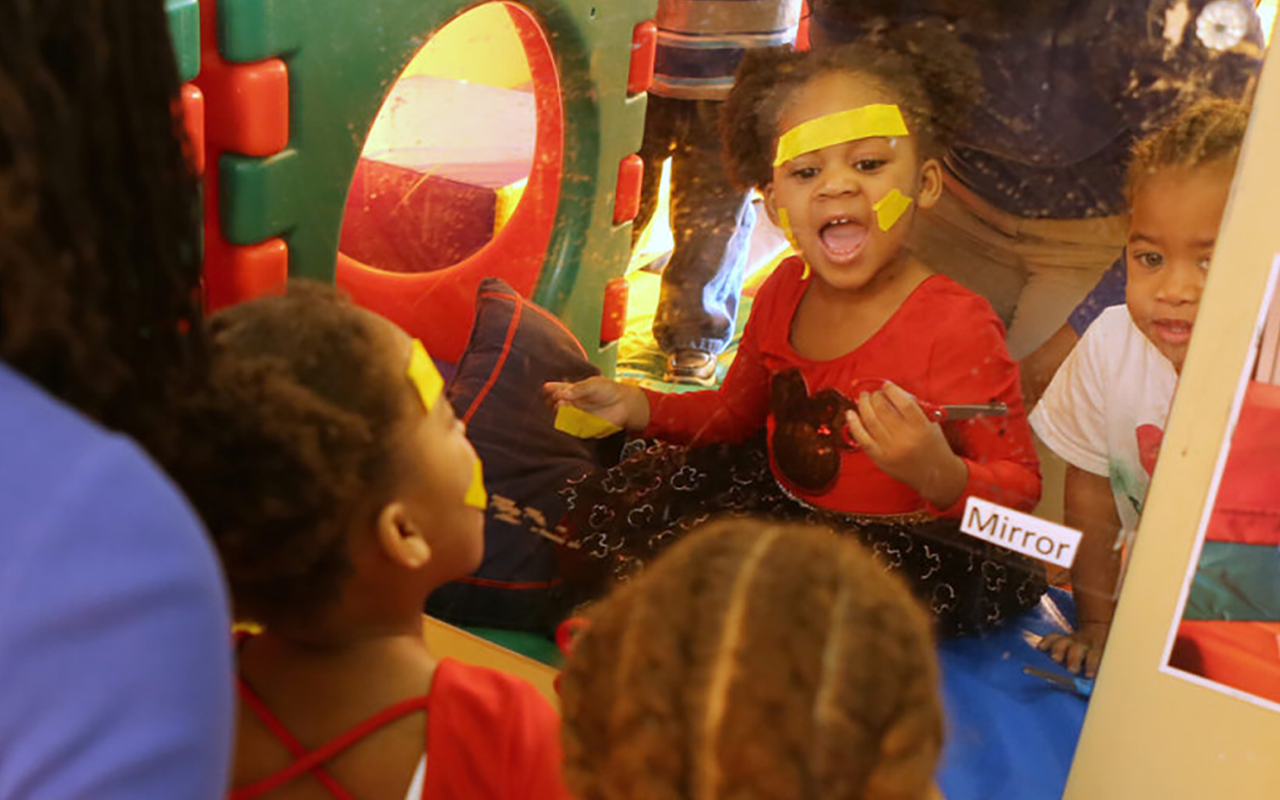Early Head Start boosts essential brain growth in the critical first three years of life. It supports children, families and early childhood teachers
Ebony Stevens didn’t worry much when her third child, Ivory, didn’t talk at age one. Life was too hectic, with working nights full time and juggling Ivory’s care among herself and her two teenage daughters, Ni’Ja and Chloe.
Just before Ivory turned two, Stevens left her job for a full scholarship to earn a degree in nursing. In the midst of going to classes, studying, caring for her children and making ends meet, she realized that Ivory wasn’t saying even 10 words. She grew alarmed.
“As a mother, it’s normal to say to your daughter, ‘Hey, let’s have breakfast,’” she said. “And your daughter would say, ‘Okay, Mom, I want pancakes,’ or ‘I want cereal.’
“Not having that — it’s heartbreaking. As a parent, I wondered what I didn’t do to give Ivory what she needs.”
Finding experts to help Ivory — and paying for them — was overwhelming. But then Stevens found the college’s Early Head Start (EHS) Partnership program, funded by the U.S. Department of Health and Human Services in 2015.
EHS serves 160 children and their families in four high-poverty Columbus zip codes. With 4,866 EHS-eligible infants and toddlers, the majority who have working parents, high-quality child care is an urgent need in those areas. Yet before EHS, it was unaffordable.
Stevens’ daughter Chloe had attended preschool at EHE’s Schoenbaum Family Center at Weinland Park. She liked its focus on high-quality early education, research, training students and policy. So she rejoiced when Nicole Hill, family services manager with Community Properties of Ohio, a program partner, said Ivory qualified for EHS.
Once Ivory entered the classroom, Hill and lead teacher Latoya Jackson began to offer resources and services from more EHS partners.
“Whether it’s medical or social service, we help link families to appropriate referrals so they get the support they need,” Hill said. Some families face utility cutoffs. Others’ cars break down and they can’t get to work. Some need better jobs, and some are homeless.
EHS uses a two-generation approach to help families move out of poverty. The program’s partners work with parents to help them set goals for themselves and their children, birth to age four.
 The program is considered a national model because of its use of multiple partnerships, compared to other EHS grantees.
The program is considered a national model because of its use of multiple partnerships, compared to other EHS grantees.
“We’ve leveraged expertise in the community to provide families with high-quality early learning and comprehensive services,” said Jane Wiechel, executive director of EHS and of community programs at the Schoenbaum.
Her vision for EHS came after years at the Ohio Department of Education and experience with families in the under-resourced Weinland Park neighborhood.
By partnering, “we’re not duplicating efforts,” she emphasized. “It makes our dollars go farther.”
For instance, Gail Whitelaw, faculty and director of Ohio State’s Speech-Language-Hearing Clinic, ensures that hearing screenings are completed for all EHS children. “About 30 percent of our children didn’t pass, which is huge,” said Sherrie Sutton, EHS assistant director. “If children can’t hear, they can’t learn. Some had ear infections or congestion, but some needed full evaluations.”
For children like Ivory, services are arranged with partners such as Nationwide Children’s Hospital for medical checkups, Saint Vincent Family Center for mental health assessments and Ohio State’s Nisonger Center for speech pathology and other developmental services.
Hill scheduled a screening by Columbus City Schools and went with Ivory and Ebony to the appointment. Jackson also did two screenings. They confirmed Stevens’ hunch. “Ivory was 2 1/2,” said Jackson, “yet in terms of her speech, she was functioning like a 1 1/2-year-old.”
Ivory’s developmental needs are not unusual. Wiechel said that in a 2012 assessment of 2,923 young children in Franklin County, half of whose families made less than $10,000 yearly, a fourth needed referrals for social-emotional, physical or cognitive skills and 18 percent more needed monitoring.
 Currently, half of children in Columbus City Schools, which includes EHS targeted neighborhoods, don’t start kindergarten ready to learn. If children start school behind their peers, research shows they tend to fall further behind each year. Some are moved to special education for their remaining years in school. Others become discouraged and drop out. They may struggle to find living-wage jobs.
Currently, half of children in Columbus City Schools, which includes EHS targeted neighborhoods, don’t start kindergarten ready to learn. If children start school behind their peers, research shows they tend to fall further behind each year. Some are moved to special education for their remaining years in school. Others become discouraged and drop out. They may struggle to find living-wage jobs.
High-quality early education can be pivotal. “With early intervention, they may not even need services by the time they reach kindergarten,” Sutton said.
“The research is clear,” Wiechel said. “Between birth to three is an incredible time when 85 percent of the brain’s learning potential develops. If you don’t fire those synapses, you’re losing them.”
Research also shows some children have heard 30 million fewer words, compared to others, by their fourth birthdays. For Ivory, intervention goals first focused on adding three new words to her vocabulary each week.
Jackson and her team also planned varied experiences for Ivory. “She enjoys sensory, so we’ll mix shaving cream and paint and she’ll paint herself,” said Jackson, a master teacher. “We’ll talk about the colors, how it feels. Is it hot? Is it cold? We deep dive into all aspects of the experience.”
One-to-one speech services from the Nisonger pathologist also helped Ivory progress. “At first, she would say, ‘Hi, bye, Ma,’” Jackson said. “Four months later, if Ivory wanted more to eat, she’d say ‘more.’ If another child fell down, she’d say, ‘You okay?’ She’s understanding that words have meaning.”
Teachers at the 11 centers in the EHS program, plus the eight home-based care providers, receive practice-based coaching to improve skills. “Coaches collaborate with teachers, supporting them in improving or refining their teaching practices. Together, they assess needs, set goals and create action plans,” said Jessica Woodruff, lead coach.
“Coaches also observe teachers in the classroom, then provide feedback and resources,” Woodruff said.
Teachers must intentionally teach in five learning domains essential for children’s long-term success. In the social-emotional development domain, “we talk a great deal about supporting children in regulating their emotions,” Woodruff said.
“Teachers learn to help children process. ‘If I’m angry, how do I get myself to a good state?’ That’s because research shows if children don’t feel safe and connected, they won’t be in an optimal state to learn.”
EHS teachers’ scores in supporting social-emotional improved from 68 percent to 83 percent since last year.
It’s not easy to offer intentional learning all day, but research underscores the benefits to children.
A diaper change must offer as much learning as story time. Coaches help. When Ivory joined the class, Jackson asked her coach for advice in the language and literacy domain. Stacy Orbaker noticed Ivory was trying to interact using hand signals.
“I wondered why she was waving all the time,” Jackson said. “Stacy saw she was trying to signal ‘stop’ or ‘come play.’”
 Orbaker also helped Jackson work with Ivory’s mom. “At first, Ivory was tired when she came to school. Stacy suggested creating a chart of Ivory’s routine, including sleep, so she would come to school ready to learn.”
Orbaker also helped Jackson work with Ivory’s mom. “At first, Ivory was tired when she came to school. Stacy suggested creating a chart of Ivory’s routine, including sleep, so she would come to school ready to learn.”
Wiechel’s hub concept also helps teachers support each other. “One center in each zip code, rated high in quality, serves as a resource to our other providers in the area,” Sutton said. “They do family engagement nights and professional development together.”
When center directors ask to send their other teachers to training even though they’re not in classrooms with EHS slots, Woodruff always says yes. As more teachers benefit, high-quality early education expands.
Best of all, Ivory is now speaking. “The other night, we were about to brush our teeth,” Stevens said. “Ivory held up a brush and said, ‘Toothbrush.’ I said, ‘Thank you. Now can you put on your house shoes?’ and she said, ‘I can.’ Simple things like that mean so much to me.”
Wiechel sees EHS as providing equity to children like Ivory. “Unless a child has a delay or disability, they all come into this world with the same brain potential to learn. It’s so dependent on their situation, their environment and what they have access to. No child is less deserving than another.”

